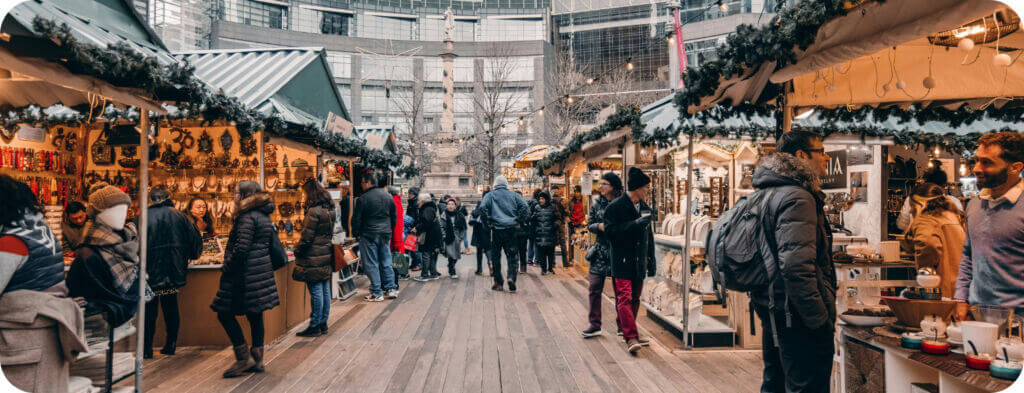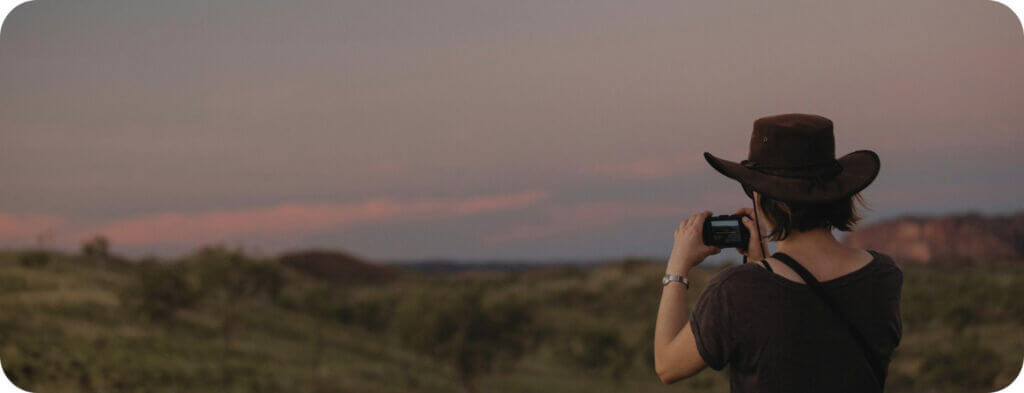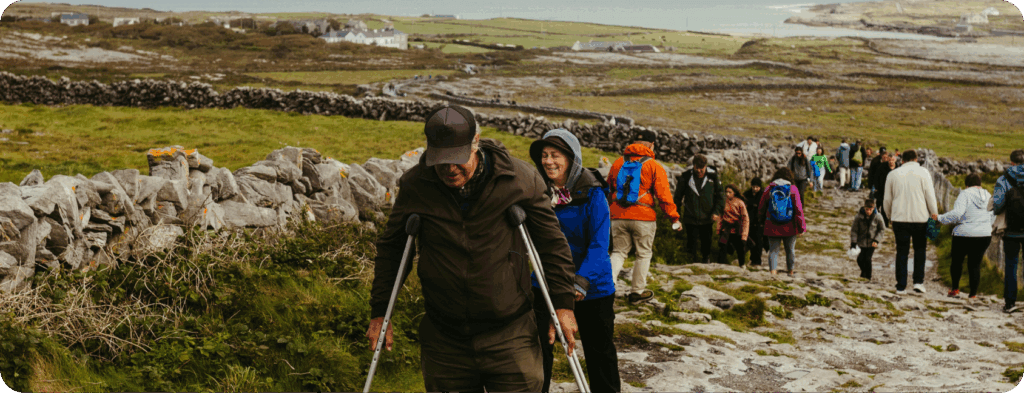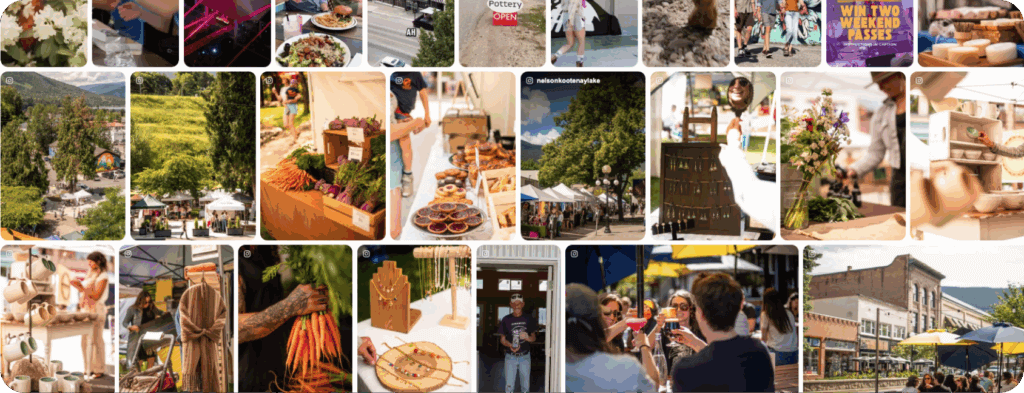
Most DMOs don’t have hundreds of employees or multi-million dollar budgets. They are teams (perhaps just like yours) made up of a handful of passionate tourism marketers who need to make the most of the resources they have.
That’s getting harder and harder to do.
Years ago, DMOs could put a couple of ads into a seasonal brochure, set up a stall at an event and get local travel agents to sell their destination.
Now?
Travelers crave real stories from real people. The kind of stories that grab your target audience’s attention and convince them to put your destination on their list of must-visit places. The good news is a successful destination marketing strategy is something every DMO can execute—with the right planning.
Let’s talk about how DMOs can do less with more with these destination marketing strategies 👇
What’s ahead
What Is Destination Marketing?
Destination marketing is any activity that promotes a country, region, or city to attract more visitors.
It’s an overarching strategy that digs into who your target audience is and what they want out of their trip. These considerations are then used to create targeted, engaging campaigns to entice potential visitors to book a trip to your destination.
So, how exactly does it work?
Most destination marketing strategies have several layers:
- Brand awareness. Travelers do a lot of research before they step foot on a plane (or train, car… boat?) to get to you. A destination marketing strategy can paint an image in their mind about what they will experience during their visit. Destination branding can amplify the highlights and hidden gems of a region as well as amplify stories of other happy visitors to get people excited about their trip.
- Community support. Destination marketing aims to power every corner of a local economy. A successful strategy will have partnerships with local businesses and tourism operators to create content and advertisements to drive visitors.
- Local initiatives. Is your region all about sustainability and eco-tourism? Celebrating local heritage? Being a safe and welcoming place for minority travelers? Your destination marketing strategy can make these initiatives your superpower and demonstrate to visitors why your destination is the perfect place for their next vacation. (Pssst, if you’re looking to build a sustainability strategy, check out our comprehensive Sustainable Tourism eBook!)
But (and there is a but), nailing destination marketing isn’t easy. There are some hurdles even the most seasoned Destination Marketing Organizations struggle with 👇
Travel Industry Challenges: Where Do Destination Marketers Struggle Most?
DMOs must engage with travelers throughout their buyer journey, from creating awareness, to inspiring action, and providing key information for planning the details of a trip.
It’s easier said than done. Many DMOs try to hit these goals but battle against the constraints of small teams and limited budgets.
CrowdRiff’s 2024 Trends Report found 61% of teams pump out content on an annual budget of $200,000. Only 20% have budgets of $600,000 or more. These numbers show it’s important for DMOs to get savvy and find ways to do more with less.
Here are some of the biggest hurdles 👇
📲 Picking the right social media channels. 77% of travelers now use socials in the early stages of trip planning. But where should DMOs start? TikTok. Instagram Reels. YouTube. Facebook. It can be difficult to decide what channels will resonate best, especially with constantly changing social media trends and shifting algorithms.
🤝 Getting buy-in from locals. DMOs rely on the unique voice of their destination to attract visitors. However, not every local is on board with more tourists in their area. DMOs must find ways to work better with local tourism partners to avoid resistance.
👀 Finding content creators/influencers. Unfortunately, there isn’t a roadmap for how to work with non-traditional strategies like influencer marketing. It can be a minefield to find a social media content creator who can tell your story, connect with your audience and fit into your budget. (Note: This is exactly why we launched CrowdRiff Creators, which we will talk about later 👀)
📈 Measuring campaign success. Every social media marketing campaign should track metrics like conversions, impressions and audience insights to measure success. But not all of us are social media gurus and—without the right analytics tools—it can be a tough learning curve.
Understanding where to focus strategic marketing services for maximum impact is a challenge for DMOs. However, DMOs can overcome these challenges with a strong social media strategy, knowing their target audience and amplifying diverse voices. And these things can be done even on the tightest budgets.
Here are five ideas to market your destination 👇
Destination Marketing Strategies: 5 Ideas To Promote Tourism
How are DMOs overcoming the above challenges to successfully promote their destinations? Let’s take a look at how to build a high impact tourism marketing plan that brings in results.
1. Expand Your Reach With More Diverse Representation
Travelers want more than a vacation—they want to feel welcomed like a local. To truly meet visitor expectations, DMOs should showcase everyone that makes up their region, including local stakeholders, unique experiences, and minority communities.
According to Pew Research, post-Millennials are the most ethnically and racially diverse generation, and 42% of travelers want to visit a destination that supports Indigenous cultures and heritages. DMOs can tap into these key demographics and celebrate diverse voices to add authenticity to a campaign.
Here’s a few tips to ensure your DMO’s marketing is inclusive:
🗣️ Use their voices. Tap into the diversity in your area to foster collaboration and hear their perspective. Hold social media take-overs across different communities or spotlight the stories of your diverse neighbors.Tactics like these allow your audience to see your destination from different points of view, and you get to avoid bias and create content that will truly resonate. Oh, and no matter who you work with, make sure you credit them!
📦 Think outside the box. Be bold and talk about underrepresented topics to grab your audience’s attention. Destination Canada did this by promoting Indigenous traditions and talked about throat singing in a recent TED talk series. Your audience wants to learn, so give them the information to do it. (Pssst: We wrote an eBook on how to build bridges with Indigenous Tourism if you want to continue learning how to be more inclusive! 📖)
👍 Ensure content is accessible and respectful. True representation means making your content available to everyone. Add alt text to social media images, closed captions on any videos, and be mindful of any cultural sensitivities. Also be aware of updated terminologies to avoid disrespecting readers. If you have a global audience, consider multi-language campaigns and captions.
Visit Phoenix uses a mix of UGC imagery and diverse voices to increase the representation on its marketing campaigns and website. The Visit Phoenix website includes resources on LGBTQ+ and accessible travel, and images of real people make these resources authentic. Steven Totten, who is part of Visit Phoenix’s marketing team, says DEI has become a natural part of the DMOs work.
“We have a shared doc called ‘Stories to Tell’ and this is where everyone from our marketing department adds ideas, like ‘Oh, I learned about this interesting business or there’s this iconic person we want to highlight. They all happen to fall under the DEI spectrum.”
Steve Totten, Visit Pheonix
The DMO has incorporated diverse representation in every corner of its digital marketing strategies:
🌈 They look for UGC that shows underrepresented groups living their everyday lives, like LGBTQ+ individuals outside of Pride festivities, to highlight the region’s diversity
🧑🏼💻 The travel marketing team checks its CrowdRiff database daily for new UGC assets to use in Visit Phoenix’s galleries. The 7,000+ assets allow the DMO to collaborate with local AAPI, BIPOC and LGBTQ+ communities to promote inclusive travel
These assets are then used on social media platforms and the DMOs homepage to celebrate the diverse communities that make Phoenix unique. Not only does this help the DMO tell interesting stories, it taps into more target markets to attract more visitors.

2. Leverage the Insider Knowledge of Local Creators To Gather Short Form Video Content
Travelers love short-form video content.
TikTok is now a major player in the travel planning and booking process. The platform reports that since 2021 there has been a 410% increase in views of travel content. For European TikTok users, 71% say they’re likely to book a vacation based on recommendations they’ve seen on the platform.
These stats show DMOs have a unique opportunity to tap into social media audiences and get on their radar.
Think about when COVID-19 hit. Tourism really felt the pinch. Without interstate and international visitors, many DMOs turned to locals to fill the gap.
This is exactly what happened when—almost overnight—Torontonians became Destination Toronto’s only customers. The DMO pivoted and launched a campaign called “Never Have I Ever, TO”. It encouraged residents to rediscover the city they lived in—to explore new neighborhoods, eat at different places, and dive into local culture.
Torontonians responded (very) enthusiastically, ready to share their favorite parts of the city on social media. The campaign also asked locals on the street about parts of the city they had never seen:
On the back of locals’ tips, Destination Toronto created neighborhood guides packed with hidden gems and unique itineraries to help residents explore.
This campaign is great. But producing short-form video content like this is time consuming, especially with a restricted budget. That’s why we built CrowdRiff Creators. DMOs can outsource content creation to scale short-form video production and gather unique assets from talented creators.
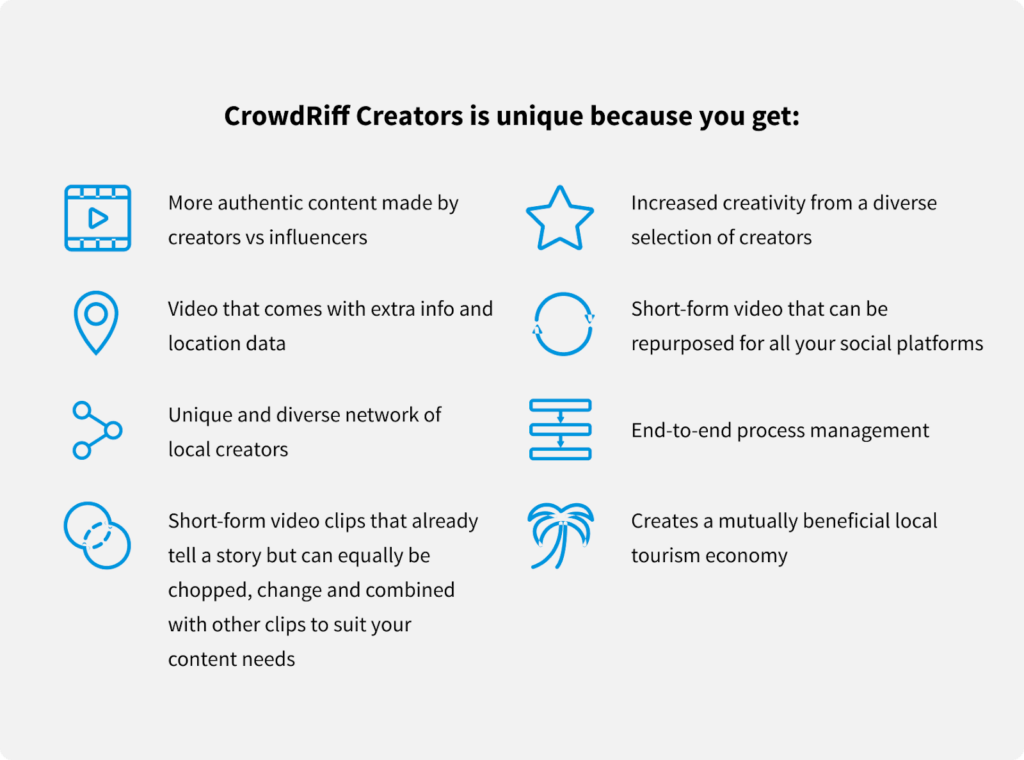
These local creators don’t just create clips to use across your social media channels—they know your area inside out. Local creators know the best places to eat and explore, and they are ready to share. Tapping into their knowledge can provide a wealth of content for DMOs with limited resources.
Elevate Your Destination Marketing Strategy with Short-Form Video at Scale
3. Increase Website Engagement With UGC Imagery
User-generated content (UGC) is content like images and videos posted by people online, mainly on social media platforms.
DMOs can leverage this content on their own channels to save time, connect with their audience and maximize even the smallest budget.
You might already be sharing UGC on your social channels, but UGC can add value at every stage of the traveler’s buying journey. DMOs can use UGC images on their websites to boost time on site, the number of page views, or scroll depth.
Some ways to introduce UGC into a tourism marketing campaign are:
🧑💻 Embed images. First, use images from happy visitors to tell your story
🤳 Spread the (UGC) word on socials. Then, recycle this UGC across your social media channels to maximize reach
🎟️ Drive conversions with UGC. Finally, link UGC directly to your marketing ef forts. This could be ticket sales, events, or even full destination packages. Just embed a link into the UGC and direct potential visitors to your site 👌
Using UGC to power campaigns is the exact strategy Dollywood used to earn more than $90,000 in bookings. Their destination marketing strategy was simple. Instead of trying to sell tickets, they let their happy customers do it for them.
The first change was embedding a CrowdRiff Gallery to Dollywood.com. This Gallery automatically pulls images from social media using CrowdRiff’s Rights Management feature and creates a page packed with real, authentic customer experiences. When a website visitor clicks on an image from the gallery, they don’t just get a caption—there is a link that takes them straight to Dollywood’s ticket portal:

The addition of UGC and targeted conversion links has paid off big for Dollywood:
📈 On-page engagement has increased by 25%
🎢 42% increase in views and interactions on the “Rides and Attractions” page
💰 $90k in ticket sales booked directly through embedded UGC links
Instead of recycling a handful of marketing images in campaigns, Dollywood now uses fresh images to showcase its destination to visitors.
4. Speak to Concerns Like Sustainability & Local Economies
Travelers are increasingly driven by values when choosing their next travel experience or a particular destination. The impacts of climate change, overcrowding, and a lack of local housing in many places are prompting visitors to think more carefully about travel choices.
According to Booking.com’s 2023 Sustainability report, 53% of people say recent news about climate change has influenced them to make more sustainable travel choices. A further 43% have traveled outside of peak season to avoid overcrowding.
What’s interesting is that the same report showed 69% of travelers want their purchases to stay within the local community. This gives DMOs an opening to celebrate smaller businesses and highlight how buying from them can help with sustainability and local economies.
This is the exact approach Visit Lake Tahoe took in a recent campaign. The aim of the campaign was to tackle sustainability by promoting shoulder seasons and lure travelers away from the overcrowded summer and winter months.
The campaign focused on some key opportunities:
- Encourage travelers to visit throughout the year, rather than just at peak winter/summer times
- Target audiences not traditionally focused on sustainable tourism
- Partner with paid media in Seattle and Portland to drive travelers up North
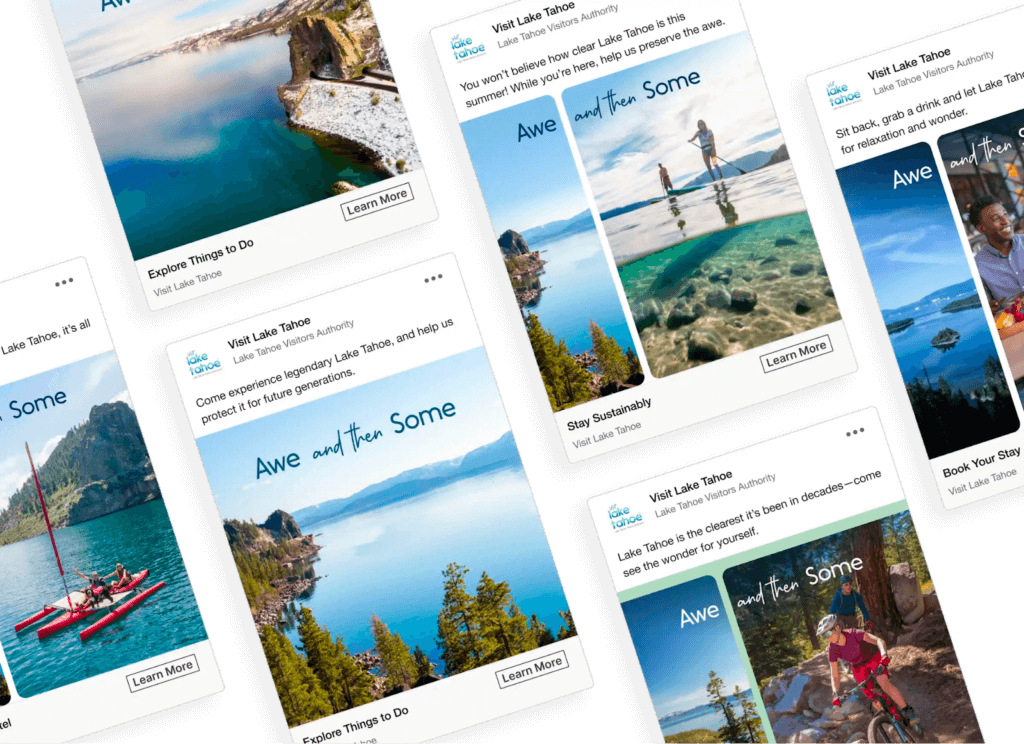
According to the DMO’s case study, this messaging struck a chord.
8%
higher overnight visitor rate
2%
growth in average visitor spending
9%
increase in year-over-year visitors
Now, people look at Lake Tahoe not just as a winter or summer destination, but as an all-year round spot to take a vacay.
5. Tap Into Your Target Audience’s Curiosity
Understanding the motivations and behavior of the visitors you want to attract is key to balancing effective destination marketing with a sustainable visitor economy.
As mass tourism crowds out popular places, for example, more people are seeking off the beaten track experiences. The American Express Travel 2023 Global Travel Trends Report names traveling off the beaten path as the number one trend for 2023, with 68% of survey respondents agreeing that they pride themselves on finding lesser-known vacation spots before they become popular.
This trend is an opportunity for DMOs to tap into the sentiment of curious travelers, while also addressing the social and environmental needs of local communities.
💎 Highlight “hidden” gems. Visitors don’t want to see what everyone else is seeing. But they also want to go to places that are prepped and ready for tourists. Think about what areas only locals know about that don’t get enough love but have the resources to welcome new visitors. Promote these hidden gems alongside your other big attractions in your next campaign.
🌮 Uncover local spots to eat. Food and drink is a major part of every traveler’s experience. 87% of us now want immersive, authentic, cultural experiences. Another 53% of travelers want hyper-local, neighborhood-to-table dining—so seek out those hole-in-the-wall hotspots.
Tourism New Zealand tapped into these desires with its recent If You Seek campaign.
The DMO knows its target audience inside-out—they are curious adventurers and want to visit places off the beaten track. Instead of promoting Hobbiton or Waiheke Island, the campaign highlighted places that were off the beaten path. This included places like Tāne Mahuta and Hell’s Gate which already had the facilities in place to welcome an influx of travelers, but locals still considered them hidden gems.
“We wanted to tap into the curiosity of our target high–quality traveler, who we know are adventurous and keen to dig beneath the surface of the places they visit.”
René de Monchy, Tourism New Zealand chief executive
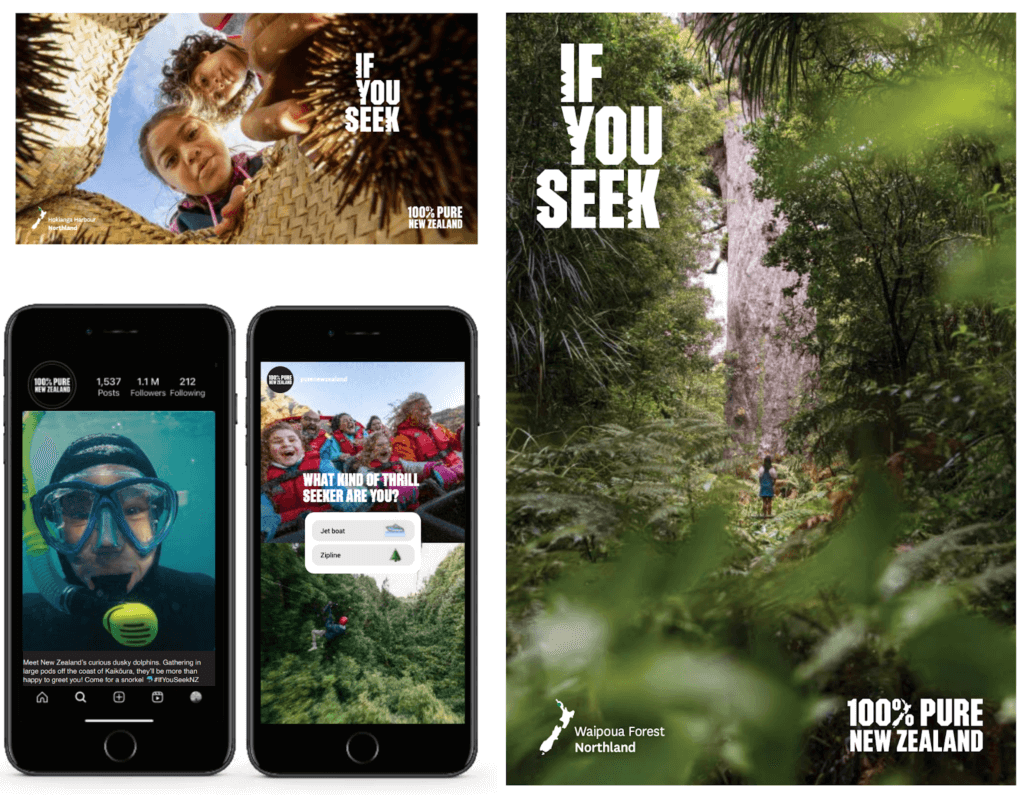
The campaign worked. Video views reached 135M, there were 1.3M visits to the DMO’s website, and 178K referrals were made to tourism operator websites.
Use Content to Drive Your Destination Marketing Campaigns
Expensive, polished marketing content is out. Authentic, user-driven content is in.
DMOs are at a crossroads with destination marketing. Visitors don’t just want to see the “biggest” or “most popular” attractions promoted to them anymore. They want something different and unique. They want a destination to post on their Instagram Story to give all their friends FOMO.
Meeting these expectations starts well before a visitor steps foot in your destination.
A destination marketing strategy can promote your region as a place that celebrates diversity, helps local businesses thrive, and wants to share hidden gems with outsiders. Once you know what your target audience is looking for, you can use it to craft compelling content and convince them to book their tickets.
So… are you ready to use authentic content to take your destination to the next level? 🤔
Own your destination’s story and build a compelling strategy to attract more visitors.
Download our guide to UGC to learn how to turn authentic experiences into higher visitor numbers.
The Ultimate Guide to User-Generated Content for Travel & Tourism Brands